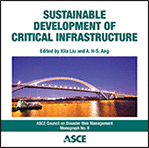Reliability-Based Design Criteria for Infrastructure Systems--A New Look
Publication: Sustainable Development of Critical Infrastructure
Abstract
The existing reliability-based codes for structural design must rely on "calibration" in specifying the required level of safety. This means that the safety level underlying a reliability-based design will be the same as that of the current traditional code-based design. In other words, reliability does not contribute to the decision on the required safety level for the design of structures or infrastructure systems. It relies on what is in existing codes of structural design. Proposed is an alternative for the development of reliability-based design in which the decision on the required safety level does not depend on "calibration"; instead, it is based on acceptable risk or risk-averseness. For this purpose, uncertainties are divided into two broad types - namely, aleatory and epistemic. The aleatory type is associated with the variability in the observed information (or data-based), whereas the epistemic type is associated with one's inability to accurately estimate or predict reality (i.e., knowledge-based). The two types of uncertainties can and should be treated separately. In either case, the same probability principles are required and adopted. The effects of the aleatory type are represented in terms of a failure probability; whereas, due to the effects of the epistemic type, the relevant failure probability (or safety index) becomes a random variable. Values within this random variable correspond to different confidence levels. To ensure an adequate safety level of structures, a high confidence level would be appropriate (e.g., the 90% or 95% confidence). Observe that the mean value of the safety index (obtained with the existing total uncertainty approach) is associated with a 50% confidence level which is obviously too low for ensuring safety of structures; thus, the need for calibration. The proposed approach is illustrated with examples of the design of simple structural elements. Also, the safety levels of major infrastructure systems are examined for the purpose of identifying the confidence levels underlying current engineering practice.
Get full access to this chapter
View all available purchase options and get full access to this chapter.
Information & Authors
Information
Published In
Copyright
© 2014 American Society of Civil Engineers.
History
Published online: May 14, 2014
ASCE Technical Topics:
- Business management
- Confidence intervals
- Design (by type)
- Engineering fundamentals
- Infrastructure
- Mathematics
- Practice and Profession
- Probability
- Public administration
- Public health and safety
- Safety
- Statistics
- Structural design
- Structural reliability
- Structural safety
- System reliability
- Systems engineering
- Systems management
Authors
Metrics & Citations
Metrics
Citations
Download citation
If you have the appropriate software installed, you can download article citation data to the citation manager of your choice. Simply select your manager software from the list below and click Download.
